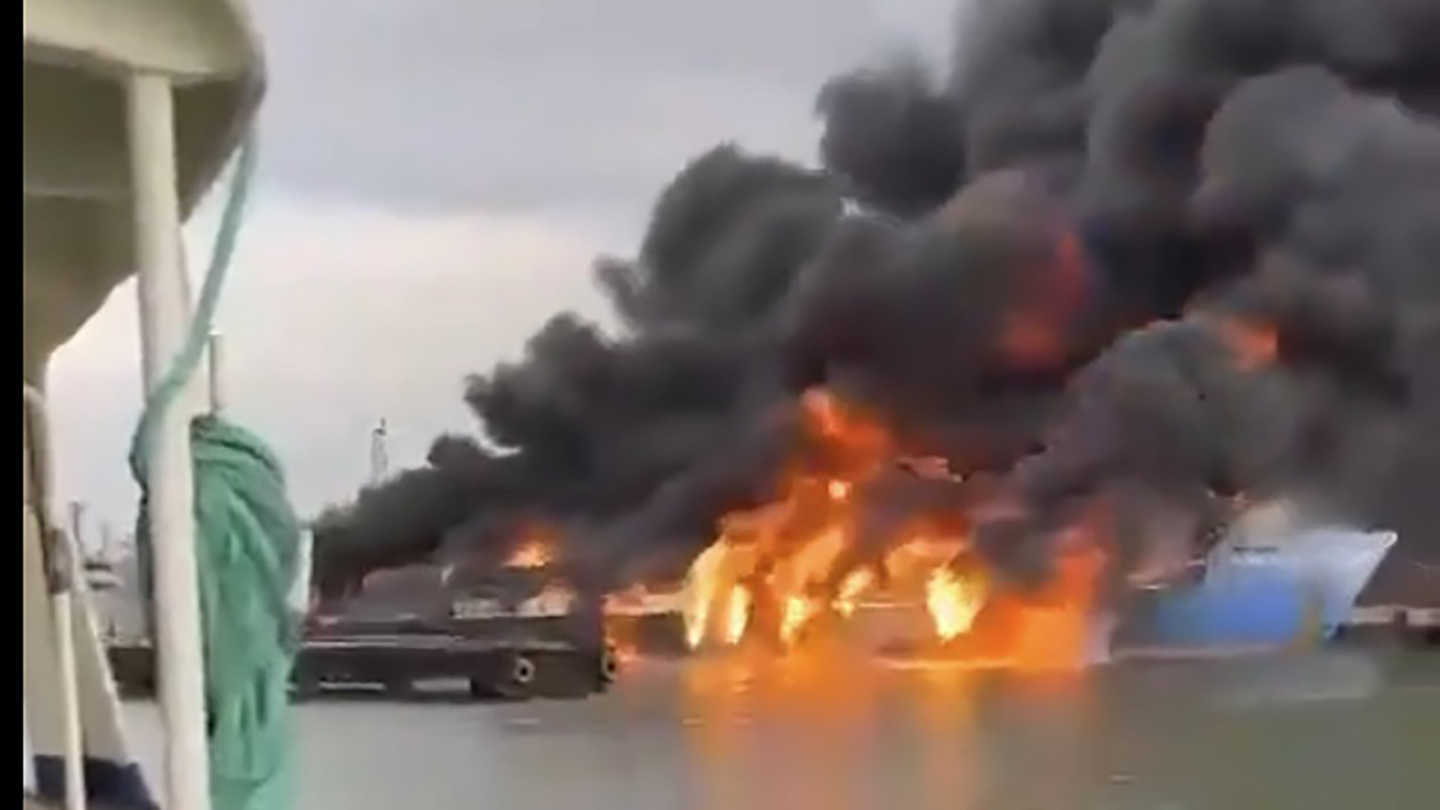A Russian Roll On Roll Off (RORO) vessel full of fuel train cars was struck and sunk by a Ukrainian missile near the Kerch Bridge, Russian media and milbloggers are claiming. The fate of more than a dozen crew members after the attack on the Kerch Strait port of Kavkaz remains unknown.
“After the Ukrainian Armed Forces struck with a Neptune missile, 15 people who were on board the Conro Trader with fuel tanks went missing,” the Russian Baza news outlet reported on Telegram. “The vessel, damaged as a result of the attack by the Ukrainian Armed Forces, sank in the waters of the port of Kavkaz. This was reported by the operational headquarters of the Krasnodar Territory. They added that there are no sources of fire on the territory of the port itself.”
After the attack, videos emerged on social media showing the ship engulfed in flames, with thick black plumes of smoke rising into the air.
The fire and flames were visible far in the distance.
The Conro Trader was carrying 30 fuel tanks when it was hit, Russian milblogger Vladimir Rogov claimed on Telegram. A dozen fire brigades, three ambulance brigades and other first responders are at the scene, he added.
“Fuel supplies to Crimea go via different routes, problems do not threaten the peninsula,” he explained, citing Crimean authorities.
Traffic on the Kerch Bridge was temporarily halted as a result of the strike, the Russian SHOT news outlet said on Telegram.
The claim that the ship was struck by a Neptune missile is plausible, a Ukrainian defense official told us. As we first reported a year ago, Ukraine has adapted the indigenous Neptune anti-ship missile for longer range and land-attack capability.
The missile likely traveled about 150 to 180 miles to hit Kavkaz, said the official, adding that the converted Neptunes have a maximum range of 190 miles with a 350-pound warhead.
The Neptune had previously gained notoriety after two were used to hit the Russian Navy’s Project 1164 Slava class cruiser Moskva in the Black Sea in April 2022. You can read more about that in our story here. The missile had just entered very limited service when the war began, with few on hand for operational applications.

It’s thought that the land attack Neptune uses and imaging infrared seeker with scene/image matching to prosecute its terminal attack. This would make sense for hitting a docked ship, just as Storm Shadows and SCALP-EGs that use a similar guidance system have done repeatedly. Traditional anti-ship missiles with radar seeker’s are not well suited for striking ships in complex port areas.
Still, we cannot confirm what struck this vessel — a Neptune or any other type of weapon — if anything struck it at all. There is also the possibility that an accident onboard resulted in the destruction seen in the clips above.
If indeed Ukraine attacked the Kavkaz, it would be just the latest Ukrainian strike on Russia’s energy supply and infrastructure.
A massive fire at a Russian oil depot in Proletarsk, Rostov region is still burning five days after being hit by Ukrainian drones. It is located about 250 miles from the front lines.
The governor of Rostov on Thursday said at least 13 firefighters have been hospitalized after fighting the blaze and that several measures are underway to try to douse it.
“To prevent the occurrence of a landscape fire nearby, additional mineralized strips have been created around the industrial site, Vasily Golubev said on Telegram. “Also, two water drops were carried out on the adjacent territory today by Il-76 [Candid] aircraft of the Russian Emergencies Ministry.”
“I regularly receive reports on the progress of extinguishing,” he added. “According to experts from operational rescue units, there is no threat of the fire spreading to residential buildings and other objects.”
These attacks are hurting Russia’s economy, which relies heavily on energy exports. Though it still appears to be providing natural gas to Europe, one of the first targets of the Kursk invasion was the Sudzha gas metering station. It is “the last operational trans-shipping point for Russian gas exports to Europe via Ukraine, according to Reuters.
While Russian strikes on Ukraine’s power infrastructure have caused widespread damage, Ukrainian attacks on Russian fuel depots and electrical grid are taking a tremendous toll as well, said Pavel Luzin, Senior Fellow, Democratic Resilience at the Center for European Policy Analysis (CEPA).
“I think this upcoming winter can be the first winter when people on the Russian side will feel more harder times than people on Ukrainian side,” he said during a panel discussion Thursday morning about Ukraine’s Kursk invasion.
Update: 8:01 PM Eastern –
A new video emerged of the Conro Trader loaded with fuel tank train cars before the attack.
Contact the author: howard@thewarzone.com
